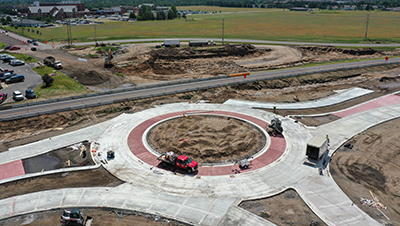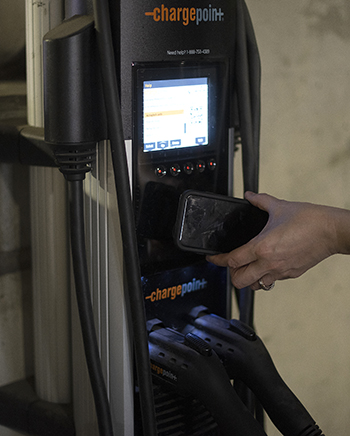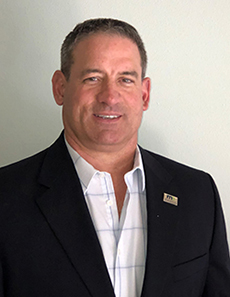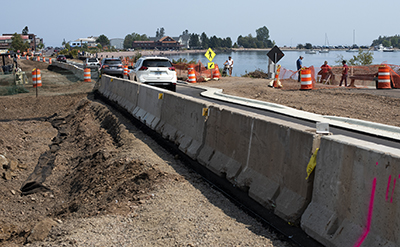 |
|

|
 |
TABLE of CONTENTS
|
Resurfacing project improves safety on Hwy 71 |
By TJ Melcher, District 2

The traffic signal at Hwy 71 and Anne Street is being reconstructed with a roundabout. The intersection serves many local businesses and regional visitors to the Sanford Bemidji Medical Center. Submitted photo
|
A comprehensive effort to improve highway safety in Bemidji continues this summer with a complex project on Hwy 71.
The $16.6 million project will improve safety at the intersection with Anne Street. Work includes constructing a roundabout and seven reduced conflict intersections situated along the five-mile corridor, which serves as an important link to businesses and the region’s largest healthcare campus,
Sanford Bemidji Medical Center, which is directly adjacent to the intersection and has grown to almost 1,900 employees.
The highway carries about 12,000 vehicles per day, so the project required a complex staging and construction plan to keep traffic moving through the construction zone, and to ensure an ongoing access for people going to and from the medical facility, including patients and emergency responders.

A bypass lane on Hwy 71 carries traffic through the construction zone as the roundabout is constructed. Submitted photo
|
Communication with local residents and businessowners has also been a point of emphasis throughout the project. MnDOT established early connections through a collaborative project design process. While preparing for construction, district staff enlisted additional support with consultant-led graphic design and required the construction contractor to use a community/business liaison.
MnDOT staff led more than 30 different outreach events, including public meetings, construction updates and listening sessions with business owners. The community liaison has logged an additional 70 notification activities with the surrounding businesses, resident customers and a direct connection to Sanford Health.
The project is scheduled to be completed in October. |
 |
|

|
 |
TABLE of CONTENTS
|
Minnesota submits Electric Vehicle Infrastructure Plan, will receive $68 million in federal funds over five years |
By Julie Bartkey

A new EV charger installed in the ABC ramps in Minneapolis. Photo by Rich Kemp
|
Minnesota took the next step in expanding electric vehicle infrastructure in the state when it submitted the Minnesota Electric Vehicle Infrastructure Plan to the U.S. Department of Transportation and Department of Energy Joint Office on July 29.
Submitting the EV infrastructure plan means the state will receive $68 million in federal funds from the National Electric Vehicle Infrastructure Formula Program over five years (FY 2022-2026), according to Siri Simons, Sustainability Program supervisor. The program requires a 20% non-federal match of $17 million.
“The EV Infrastructure Plan describes how the state will spend NEVI Formula Program funds for the first year,” Simons said. “The federal funding will help us to build on and support existing efforts to promote and expand electric vehicle use and electric vehicle infrastructure in Minnesota.”
As a part of President Biden’s Infrastructure Investment and Jobs Act, MnDOT is charged with leading a collaborative effort to distribute federal funding to install fast chargers for electric vehicles along designated corridors to provide reliable, long-distance EV travel.
The NEVI Formula Program requires that states fully build out designated Alternative Fuel Corridors before using funds for charging stations on other roadways. To meet the requirements for an AFC, a roadway must have Level 3 DC Fast Chargers located every 50 miles or less, with each one less than one mile from the corridor, and a minimum of four 150-kilowatt fast chargers per site.
The Minnesota Electric Vehicle Infrastructure Plan includes a vision and goals for a statewide fast charger network that provides convenient, reliable and accessible EV charging across Minnesota by the end of the NEVI Formula Program. The plan details the process and goals, including implementation considerations related to operations and maintenance, civil rights, equity, labor and workforce and cybersecurity. It concludes with information about how MnDOT will evaluate the NEVI Formula Program implementation in Minnesota, including annual reviews and updates to the plan, along with the potential to recommend additional roadways as AFCs.
Simons said MnDOT intends to partner with one or more third parties to design, install, operate and maintain the chargers. The Office of Sustainability and Public Health is exploring contracting options to prepare for EV infrastructure deployment.
To stay informed about the plan, visit the Electric Vehicle Infrastructure Plan page on MnDOT’s website. |
 |
|

|
 |
TABLE of CONTENTS
 |
Perkins begins permanent role as operations assistant division director |

Jeff Perkins. |
Jeff Perkins, who has served in a work out of class capacity as the Operations Division assistant director for the past year, has been appointed to that role permanently. Perkins will continue to provide leadership for MnDOT’s maintenance and operations areas, including Transportation System Management Operations, Connected and Automated Vehicle, Electrical Services Section and the Americans with Disabilities Act. He joins Chris Roy as deputy to Jay Hietpas (Roy will primarily focus on project development).
A graduate of the University of North Dakota, Perkins has more than 25 years of experience with similar work, including serving for 13 years as the District 4 assistant district engineer for operations.
“We are really excited to have Jeff in this leadership position,” Hietpas said. “With his extensive knowledge of maintenance and operation, we are going to advance several key initiatives, such as increased use of liquids to improve safety, reduce costs and meet our sustainability goals. I know Jeff is also looking forward to working with our districts and specialty offices to also improve employee safety and overall customer service.”
|
 |
|

|
 |
TABLE of CONTENTS
 |
Limited English Proficiency addendum reports now complete |
|
By Alyssa Kruzel
The Office of Transportation System Management has completed Limited English Proficiency addendum reports for each MnDOT district’s 10-year Capital Highway Investment Plan projects.
The objective of the LEP addendum reports is to assist districts in identifying CHIP projects that may require translated materials under the LEP Safe Harbor Provision, which states that translations of vital documents must be provided for each eligible LEP language group that meets a threshold of 5% (or 1,000 persons in all) of the population eligible to be served or likely to be affected or encountered.
The LEP addendum reports are intended to give project managers, planners and public engagement staff an additional tool to conduct outreach to help minimize impacts from a project, maximize benefits to the community and better inform the scoping and planning process. In addition to using this analysis, the Office of Transportation System Management encourages districts to use the Office of Civil Rights Limited English Proficiency Data Tool to identify which specific languages may be needed for translated materials and to assist them in completing the LEP four-factor analysis.
Visit MnDOTs Office of Civil Rights site for further explanation of MnDOTs responsibilities under the Title VI program and for helpful links to important LEP resources. The district LEP addendums can be found on the Public Engagement iHUB site on the home page as well as under the “Plan” and “Reference” tabs.
Please contact Brad Utecht and Kathryn Engelhardt for questions or concerns about the district EJ or LEP reports. |
 |
|

|
 |
TABLE of CONTENTS
 |
New library materials now available |
|
By James Byerly, Office of Research and Innovation The latest issue of New Library Materials is available. This issue features “Connect: Building Exceptional Relationships with Family, Friends and Colleagues,” by David Bradford and Carole Robin, available in both print and ebook formats. New Library Materials is a compilation of resources added to the library collection during the previous month. Visit the MnDOT library website and click New Library Materials to sign up. Questions and feedback are welcome at Ask a Librarian. |
 |
|

|
 |
TABLE of CONTENTS
 |
On the Job: Broderick Bell listens to the community |
By Doug Mack

Metro District's Broderick Bell has contributed to many diverse areas of the agency in his 23 years with MnDOT. His advice? Get involved, take classes, help people out and listen. Submitted photo |
Broderick Bell knows MnDOT inside and out. His career has taken him around the agency, including technical work in the field and community engagement.
How long have you worked at MnDOT and how did you start?
I have been here for 23 years. Before that, I was in the oil refinery business. I worked there for 16 and a half years. My dad worked for the Department of Transportation, so I'm a second-generation guy. I pretty much knew the business, and so I had been applying for jobs at the agency. This time I really got serious about it and I got hired in soils. I was a technician. I would gather the data and then let the engineer know what was going on. It was a great fit for me.
Are there are any specific projects that you’re especially proud of or that you found particularly interesting?
I work in community engagement now, and I absolutely love talking to different communities about different projects I’ve worked on. For instance, the Rethinking I-94 project, the Robert Street project, Hwy 61 project, the Hiawatha Avenue project, the Hwy 52 project. I can talk with a group of people and hear their questions, and the neat thing about being at MnDOT is then I can take it back to the engineer or planner and other people working on the project and let them know what the people are thinking.
How has the agency changed in the years since you started?
Some things have changed and some things haven't changed. When I started, you would see some managers hiring people who look like them, but it's changing. I think they're starting to find out that there's a lot of different kinds of people out there, with a lot of talent, who can help the agency. For example, there are a lot more people of color in transportation now, out there doing great work.
In community engagement, I always say to the public, “This isn't your father's highway department anymore. We want to hear from you. What are you thinking? We want to know your end of it.” That’s what has been the most important and interesting part of my job. We’re out there listening more.
Do you have any advice or guidance for people just starting at MnDOT?
Take all the classes MnDOT has to offer. Get involved – one way I’ve done that is with the engagement committee of the African American Employee Resource Group.
Don't sit in one space – if you see something else at the agency you want to do, see if you can get that job. There are a lot of different opportunities out there.
Remember that to get things done, try to help people out as much as you can. When you’re doing community engagement, keep your wits about you and try to weed through whatever they’re saying and get the information to the proper people.
I know you’re retiring soon. What’s next for you after you retire?
I used to coach football and basketball for many years. So now I want to start a podcast with a couple of guys and I want to promote Minnesota athletes, boys and girls – not the stars but the ones who kind of get missed. I’d like to keep going with community engagement projects. And I’ll probably get more active in the church. I’m not going to sit on my hands. All of that is related, too – it’s about getting out there and talking to people and giving some exposure to the people who need to get it.
Do you or a co-worker have an interesting job to share with readers? Send us your ideas, and we’ll contact you for more information.
Recent employee profiles:
|
 |
|

|
 |
TABLE of CONTENTS
 |
Hwy 61 project among winners in America's Transportation Awards |
By Doug Mack via AASHTO News

The Hwy 61 project in Grand Marais, completed 2021, recieved an America Transportation Award. Photo by Rich Kemp |
Eight state department of transportation won Mid America regional awards in the 2022 America's Transportation Awards competition, including MnDOT’s Hwy 61 Grand Marais reconstruction project.
The contest, which is sponsored by AASHTO, AAA and the U.S. Chamber of Commerce, honors projects benefiting their respective communities. The Hwy 61 project, which improved bike and pedestrian facilities and safety, was the winner in the Quality of Life/Community Development, Small category. Other honorees included projects in Michigan, Illinois and Iowa.
“State DOTs are overwhelmingly focused on innovative solutions to address the transportation issues of today and tomorrow, meeting challenges involving climate change, equity, resiliency, and safety,” said Jim Tymon, executive director of the American Association of State Highway and Transportation Officials. “The America's Transportation Awards program shows just how they're doing that. Whether on foot, in a vehicle, on two wheels, or by rail or transit, state DOTs are continuing to advance a safe, multimodal transportation system." |
 |
|

|
 |
TABLE of CONTENTS
 |
Seeds Day 2022: inspiring next generation of MnDOT employees |
By Kiran Sjoberg

Kaylee Klein, Construction & Innovative Contracting, was named the Seeds program student of the year. Submitted photo |
The Seeds and Phoenix programs held their annual Seeds & Phoenix Day on July 14 to bring together MnDOT’s student workers and their supervisors for a day of learning, connecting and meeting new people. The Seeds and Phoenix programs held their annual Seeds & Phoenix Day on July 14 to bring together MnDOT’s student workers and their supervisors for a day of learning, connecting and meeting new people.
The programs’ vision is to build a diverse, highly qualified workforce at MnDOT and provide quality on-the-job exposure and development opportunities for students. The Seeds program, for college students, has a goal of reaching a 100% hiring rate of students upon graduation.
Seeds & Phoenix Day provides an opportunity for program participants to meet other student workers, learn about MnDOT, and take steps toward a bright career at the agency. Students and supervisors at the event heard from a keynote speaker, talked to a panel of mentors about their job experiences and learned new skills and tactics for being successful in the workforce.
“My experience in the Seeds program has not only allowed me to work with a wonderful team of people, but it has also given me an excellent opportunity to future my career after college,” said Seeds participant Kaylee Klein.
Three awards were given out during the day’s events, recognizing the honorees for going above and beyond in encompassing the values of the programs. Klein was named the Student of the Year, Jeff Saholt was Supervisor of the Year, and Transportation System Management was the Office/District Advocate of the Year.
Saholt called the Seeds program “a win-win situation,” offering value for everyone involved. “I enjoy providing opportunities in a professional setting in the field of GIS to young, talented, and enthusiastic students in the Seeds Program,” he said. “The students gain experience working in their chosen field of study, while MnDOT gains the abilities and talents of each student. Besides the students themselves, the real heroes of the Seeds Program are the staff, Thuy Tran, Beth Friberg, and Jessica Etukudo, who provide their leadership and dedication to the program.”
Tran, the Seeds program manager, offered a thank-you to everyone involved in the programs: “We’re grateful to the students in the Seeds & Phoenix Programs for continuously learning and growing. We would also like to send our gratitude to supervisors and managers for mentoring the next generation of MnDOT employees.”
MnDOT is grateful to the students in the Seeds and Phoenix programs for continuously learning and growing, and to the supervisors for mentoring the next generation of MnDOT employees. More information on the Seeds program is available on iHUB. |
 |
|

|
 |
TABLE of CONTENTS
 |
Staff represent MnDOT at International Festival of Burnsville |

From left, MnDOT employees Justin Van Eck, Alex Molina Mendoza, Glenn Payton, Christian Guerrero, Patricia Bell and Erika Mejia recently volunteered at the International Festival of Burnsville on July 16. They are pictured here by a MnDOT snowplow that was also brought to the event. Submitted photo |
By Joseph Palmersheim
Eight staff members represented MnDOT for the first time at the annual International Festival of Burnsville event on July 16.
The employees staffed an information booth and helped members of the public into and out of a MnDOT snowplow truck at the event.
“The event was a success and we look forward to hopefully attending again next year,” said Erika Mejia, a specialist with the Office of Human Resources.
“The fair was well attended by the community and other organizations, so we were able to talk to a variety of people while also promoting our current open positions. We gained some valuable insights, along with feedback, and would like to give a shout-out to all of the volunteers who took time out of their Saturday to attend.” |
 |
|

|
|
| |
|



